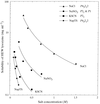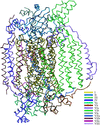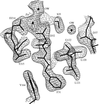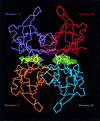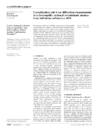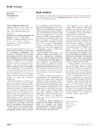issue contents
July 2001 issue

Cover illustration: The maximum-likelihood ![[sigma]](/logos/entities/sigma_rmgif.gif) A-weighted simulated-annealing OMIT map 15-3.0 Å (contoured at 2.5
A-weighted simulated-annealing OMIT map 15-3.0 Å (contoured at 2.5![[sigma]](/logos/entities/sigma_rmgif.gif) ) for the A/C binding domain of tetramer I of the monoclinic form of hTTR showing the unique orientation of T4 in the binding channel. Protein atoms closer than 3.2 Å to the ligand are colored red, between 3.2-3.6 Å are colored yellow, and those more distant are colored cyan (p. 957).
) for the A/C binding domain of tetramer I of the monoclinic form of hTTR showing the unique orientation of T4 in the binding channel. Protein atoms closer than 3.2 Å to the ligand are colored red, between 3.2-3.6 Å are colored yellow, and those more distant are colored cyan (p. 957).
research papers
Anion sites in lysozyme polymorphic structures were classified as sequence-dependent, packing-dependent and unique non-specific sites.
Nuclear-coded subunits stabilize a stable dimeric state in bovine heart cytochrome c oxidase.
The crystal structure of aspergillopepsin I from A. phoenicis has been determined at 2.18 Å resolution. In the combined S1′–S2 subsite, aspergillopepsin I is similar to endothiapepsin but differs from penicillopepsin, which shares the higher sequence identity.
PDB reference: aspergillopepsin I, 1ibq
A new polymorphic form of human transthyretin contains a unique assembly of apo TTR and TTR–T4 complex in the asymmetric unit of the monoclinic lattice. These data provide insight into the mechanism of negative cooperativity in T4 binding.
The crystal structure of ribosomal protein TL5 is the first structure of a full-size protein from the CTC family of stress proteins. Structure of TL5 complexed with RNA reveals new features of protein–RNA binding.
PDB reference: TL5–RNA complex, 1feu
The anomalous scattering of chlorine has been exploited to determine the structure of the macromolecular antibiotic vancomycin aglycon.
PDB reference: vancomycin aglycon, 1ghg
The crystal structure of NAD+ was determined by a neutron-diffraction experiment. The stereochemistry, hydrogen bonds and C—H⋯O interactions are described and compared with several high-resolution NAD+ holoenzyme structures.
NDB reference: NAD+, ur0013
The crystal structure of a left-handed Z-DNA duplex has been solved based on the anomalous signal of the P atoms with single-wavelength data collected at 1.54 Å. The redundancy of measurements crucially affects the phasing process.
PDB reference: d(CGCGCG)2, 1ick
The use of two different classes of compounds (monovalent and polyvalent cations) in the quick cryosoaking procedure for derivatization and phasing of protein crystals has been proposed. This approach was tested on hen egg-white lysozyme and was successfully employed to solve the structure of a novel protein.
A double-edge approach with a set of four wavelengths [1.0087 Å (12 291 eV, edge1), 1.0084 Å (12 295 eV, edge2), 1.0064 Å (12 320 eV, peak) and 0.9918 Å (12 500 eV, remote)] is recommended for HgMAD data acquisition.
The anomalous signal from rubidium ions bound to the protein surface was used for phasing of the crystal structure of the hsp60 apical domain from T. thermophilus. Phase quality was sufficient for autotracing of the protein model at 2.0 Å resolution.
This routine automates the steps that are usually followed by an investigator working at a graphics terminal. It is applicable to relatively low resolution maps (2.5 to 2.8 Å).
PEG is shown to promote micelle–micelle attraction and increase apparent micelle size, suggesting two mechanisms by which detergent effects can modulate the crystallization of integral membrane proteins.
crystallization papers
Crystals of T. aquaticus GlpK have been obtained by the hanging-drop method. The crystals diffract to 2.87 Å resolution and belong to space group I23.
Diffraction-quality crystals of UDP-N-acetylenolpyruvylglucosamine reductase (MurB) from S. aureus have been prepared. The crystals belong to the cubic space group I213, with unit-cell parameters a = b = c = 178.99 Å.
A recombinant thermophilic archaeal amidase from S. solfataricus MT4 that catalyzes the hydrolysis of aliphatic and aromatic amides has been crystallized. Diffraction data for the native protein (to 2.55 Å) and a putative derivative (to 2.20 Å) have been collected.
The synthetic gene of the amino-terminal domain of the antistasin-type inhibitor ghilanten (ghilanten-D1) from H. ghilianii was constructed, expressed in the methylotrophic yeast P. pastoris and purified by heparin–Sepharose chromatography. Recombinant ghilanten-D1 has been crystallized in complex with porcine β-trypsin in three different-looking but isomorphous crystal forms, each belonging to the orthorhombic space group P212121.
A novel lectin SML-2 consisting of 138 amino acids was isolated from cyst merozoites of S. muris and sequenced by Edman degradation and mass spectrometry. Crystals diffracting to 2.1 Å resolution at a synchrotron were grown by the hanging-drop vapour-diffusion technique.
4-α-Glucanotransferase from the hyperthermophilic bacterium T. maritima has been crystallized. The crystals belong to an I-centered orthorhombic space group and diffract to at least 2.6 Å resolution.
short communications
A new phase-extension with density modification procedure to improve isomorphous replacement phases is described.
book reviews
Free 



 journal menu
journal menu











